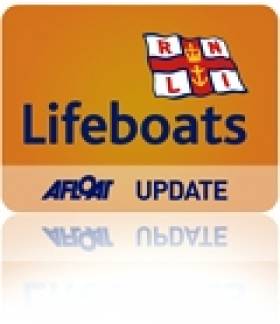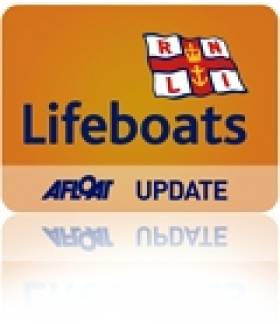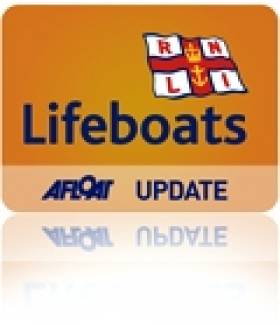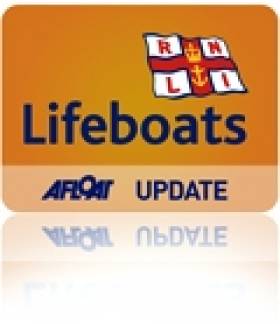Displaying items by tag: Lifeboats
Skerries Lifeboat Dispatched To Kitesurfer In Distress
#RNLI - Skerries RNLI launched on Saturday evening (24 May) to reports of a kitesurfer in distress near Shenick Island off the south strand in Skerries.
The volunteer crew launched their Atlantic 85 inshore lifeboat Louis Simson shortly after 5.30pm. The lifeboat was helmed by Conor Walsh with crew members Eoin Grimes, Stephen Crowley and Adam Scott also on board.
Dublin Coast Guard requested the lifeboat to launch after a member of public raised the alarm that a kitesurfer was struggling to get back to shore.
The lifeboat launched into a Force 4 north-easterly wind and choppy seas before proceeding directly to Shenick Island to investigate. Skerries Coast Guard and the Irish Coast Guard's search and rescue helicopter Rescue 116 were also tasked to the incident.
Arriving on scene, the lifeboat could see a kitesurfer standing in shallow water making their way toward the beach. Skerries Coast Guard were waiting on shore and were able to confirm that no further assistance was required. The lifeboat was stood down and returned to station.
Speaking after the call-out, Skerries RNLI volunteer lifeboat press officer Gerry Canning said: "In this particular case, the kitesurfer was able to make it ashore safely. However, we would still like to remind everyone that if you see someone in difficulty at sea to dial 999 and ask for the coastguard."
One Man And His Dog Rescued By Ballycotton Lifeboat
#RNLI - Ballycotton RNLI went to the rescue of a man and his dog from a tidal rock near the West Cork town yesterday afternoon (Saturday 24 May).
The volunteer lifeboat crew was requested to launch at 12.13pm at the request of the Irish Coast Guard, which had received a report from gardaí that the man and his dog were stranded on the tidal rock two miles west of Ballycotton.
The all-weather lifeboat, under coxswain Francis Morgan and with four crew members on board, launched alongside the station’s inshore boarding boat, with two crew on board, and made its way to the scene.
Weather conditions at the time were described as blowing north to north easterly winds, Force 4 to 6.
On arrival, the crew on Ballycotton RNLI’s boarding boat successfully recovered the casualties and transferred them to the all-weather lifeboat.
The lifeboat then returned them safely to the pier at Ballycotton. No medical assistance was required.
Speaking following the callout, Ballycotton RNLI lifeboat operations manager John Tatton said: "I would like to thank the lifeboat crew for their prompt and professional response this afternoon when their pagers went off, and am delighted to say both the man and his dog were returned safely to shore."
Lough Ree Lifeboat Rescues Four From Holed Cruiser
#RNLI - Lough Ree RNLI in Co Westmeath came to the aid of four people yesterday afternoon (Monday 19 May) after their cruiser got into difficulty.
The volunteer lifeboat crew was requested to launch shortly before 3.30pm following a report that a cruiser was aground on Hexagon Shoal in Lough Ree.
The boat, with two men and two women on board, was holed below waterline and was taking on water.
At the scene, the four people and their baggage were taken off the cruiser and transferred to the lifeboat by Lough Ree RNLI. They were then brought safely to the lifeboat station.
#RNLI - Portaferry RNLI's volunteer lifeboat crew were involved in the rescue of 23 canoeists who got into difficulty just off Castle Island in Strangford Lough yesterday afternoon (Saturday 17 May).
The call for help was received at 2.40pm and the volunteer lifeboat crew launched at 2.45pm.
They arrived at the scene just off Castle Island in Strangford Lough in Co Down 10 minutes later, finding six of the party of canoeists in the water.
Weather conditions at the time were cloudy with good visibility, with a slight sea swell and a Force 4 southerly wind.
The RNLI crew recovered two of the people from the water, while a small motor boat which had also come to the canoeists' aid took the other four on board.
The RNLI lifeboat crew then took their two casualties along with two canoes back to nearby Strangford Lough Yacht Club, where the casualties were put ashore into the care of HM Coastguard.
- lifeboat crew then returned to the scene near Castle Island and from there escorted the remaining 17 members of the canoe party back to the safety of the yacht club.
Commenting on the rescue, Portaferry RNLI lifeboat operations manager Brian Bailie said: "Thankfully everyone was brought safely to shore and it is testament to the training and dedication of the volunteer RNLI crew that a potentially tragic situation was averted.
"Strangford Lough is an extremely popular location for groups of canoeists and it is vital that they take all necessary precautions when taking to the water."
#RNLI - Arklow RNLI's lifeboat Ger Tigchlearr and its volunteer crew launched at first light yesterday morning (13 May) to go to the aid of a local fishing vessel.
Within minutes of the pager alert at 5.45am the lifeboat was making for the casualty vessel, which was approximately 16 miles south of Arklow, arriving on scene approximately 40 minutes later.
Once in position, the lifeboat crew secured a tow line to the casualty vessel, a 45ft local fishing vessel with four crew members aboard that had developed engine trouble and was adrift.
When the lifeboat crew made fast the towline, they proceeded to tow the casualty vessel back to Arklow. Upon arrival shortly after 9.30am, the casualty vessel was brought alongside where the crew came ashore safely.
Commenting later, Arklow RNLI lifeboat sea safety officer Mark Corcoran said: “Even experienced fishermen and sailors can be caught out while at sea, be prepared, never take chances and always wear a lifejacket.”
The volunteer crew for this shout were coxswain Ned Dillon, mechanic Michael Fitzgerald, Eddie McElheron, Andrew Loughlin, Jimmy Myler, Craig O’Reilly and James Russell.
#RNLI - Wicklow RNLI launched to assist a yacht in difficulty before 10am yesterday morning (Sunday 11 May) just as lifeboat volunteers were preparing to launch on a crew exercise in Wicklow Bay.
The call for assistance from the yacht with three people on board was received by the Irish Coast Guard, who tasked Wicklow RNLI to the scene.
Both of the station’s lifeboats were immediately launched to attend to the 27-foot yacht, which was located one mile south of Wicklow Head.
The yacht’s tiller had snapped and the crew had lost all steering control. Conditions in the area were moderately windy, with a westerly Force 4 in moderate seas.
Lifeboat crew members John Vize and Paul Sillery were put on the yacht to assist with establishing a towline. Once this was completed, the vessel was taken in tow by the all-weather lifeboat.
With no tiller on the yacht the tow back to Wicklow was slow; a drogue was rigged to assist with the progress.
The lifeboat arrived back in the harbour at 12.10pm and the yacht with three crew was secured safely alongside the East Pier.
The crew on the all-weather lifeboat were coxswain Ciaran Doyle, mechanic Brendan Copeland, Carol Flahive, Connie O’Gara, John Vize and Alan Goucher. The inshore lifeboat crew were helm Mark Kavanagh, Paul Sillery and Matt Doyle.
#RNLI - A fishing vessel that developed steering trouble in Belfast Lough was towed to safety by Donaghadee RNLI’s all-weather lifeboat Saxon, assisted by Bangor RNLI’s inshore lifeboat.
The Donaghadee lifeboat launched at 3.20pm yesterday (Friday 9 May) after a request from Belfast Coastguard.
At the scene, six miles north-east of Orlock Point, a secure tow-line was established to the stricken trawler, which had a crew of six.
The vessel was towed to Bangor Harbour where the crew of Bangor’s Atlantic class lifeboat Jessie Hillyard assisted, safely guiding the trawler to a berth at the Eisenhower Pier. The Donaghdee lifeboat stood down at 5.40pm.
Donaghadee RNLI’s lifeboat operations manager Alan Couser said: “This rescue was a fine example of swift action and good teamwork by two lifeboat crews. Another potential tragedy has been averted.”
Elsewhere, a 75-foot fishing boat St Claire was finally towed to safety in Cork Harbour by the Courtmacsherry lifeboat last night after a marathon 11-hour operation.
As previously reported on Afloat.ie, the vessel had got into difficulties earlier in the day some 35 miles off the West Cork coast.
Poor sea conditions with strong winds resulted in a slowed return journey to shore.
Courtmacsherry RNLI deputy launching authority Dermot O'Mahony said: "All aboard the trawler were mighty pleased to be in safe harbour tonight.
"I would like to commend the volunteer lifeboat crew on their quick response for what has turned out to be a lengthy call-out."
The lifeboat crew on yesterday's call-out were coxswain Sean O 'arrell, mechanic Stewart Russell and crew Dara Gannon, Ken Cashman, Gary Barrett, Ciaran Hurley and Dave Philips.
Red Bay Lifeboat Involved In Rescue Of Man Overboard
#RNLI - Red Bay RNLI was involved in the rescue Sunday afternoon (4 May) of a man who fell overboard from a boat near Cushendall in Co Antrim.
The man had fallen from the vessel near Waterfoot pier and was in the water for nearly 30 minutes. Members of the public raised the alarm.
A local fish farm boat located the man in the water and he was then moved to the lifeboat, where he was treated for hypothermia before been transferred to a waiting ambulance crew.
His condition is thought not to be life-threatening.
Wicklow Lifeboat Tows Cabin Cruiser To Safety
#RNLI - Wicklow RNLI's second call-out this bank holiday weekend – after Friday's early morning tow of a stricken yacht - saw two on board a 13m cruiser brought to safety early today (4 May) after their vessel suffered engine failure.
The station's all-weather lifeboat was launched at 6.44am and located the vessel a short time later, two miles east of Wicklow Harbour.
Volunteer crew member Terry Sillery went on board the motor cruiser to assist with establishing a towline.
Weather conditions in the area at the time were blowing a westerly force three wind and there was poor visibility.
The motor cruiser was on passage to Wales when it developed engine trouble. The owner put down an anchor so the vessel would not drift and contacted the Irish Coast Guard for assistance.
The stricken motor cruiser was towed into Wicklow Harbour and safety secured alongside the East Pier at 7.40am.
The crew on the call-out were coxswain Dave O'Leary, mechanic Tommy Murphy, Terry Sillery, Carol Flahive, Brian Sinnott, Connie O'Gara, John Vize and Alan Goucher.
#RNLI - Wicklow RNLI launched in the early hours of yesterday morning (Friday 2 May) to bring a yacht and its crew of three to safety.
The volunteer crew launched their all-weather lifeboat at 2.57am in response to a call for assistance from an English yacht with three people on board some 23 miles north-east of Wicklow Harbour.
The alarm was raised after the skipper of a yacht contacted the coastguard to say he was unable to make any headway due to insufficient wind, and was having difficulties after the boat’s engine had failed.
The lifeboat, under the command of coxswain Tommy McAulay and five volunteer crew members, located the vessel at 4.20am. A towline was passed and the casualty was towed into Wicklow Harbour, arriving safely at 6.55am.
Speaking following the call out, Wicklow RNLI lifeboat operations manager Des Davitt said: "Our volunteers are always on call and prepared to respond to any emergency at any time.
"We were delighted to be of assistance at this early hour and were glad to be able to bring these three people and their yacht safely to shore."
The lifeboat crew on the call out were coxswain Tommy McAulay, mechanic Brendan Copeland and crew members John Vize, Tommy Murphy, Connie O Gara and Alan Goucher.

































































